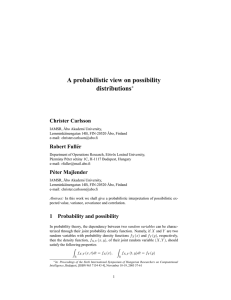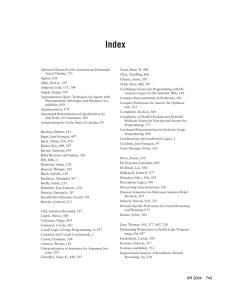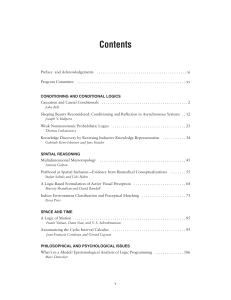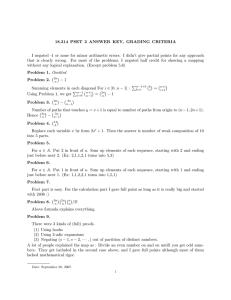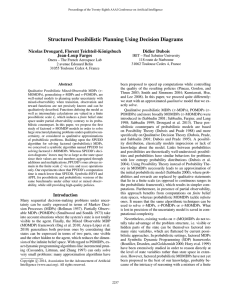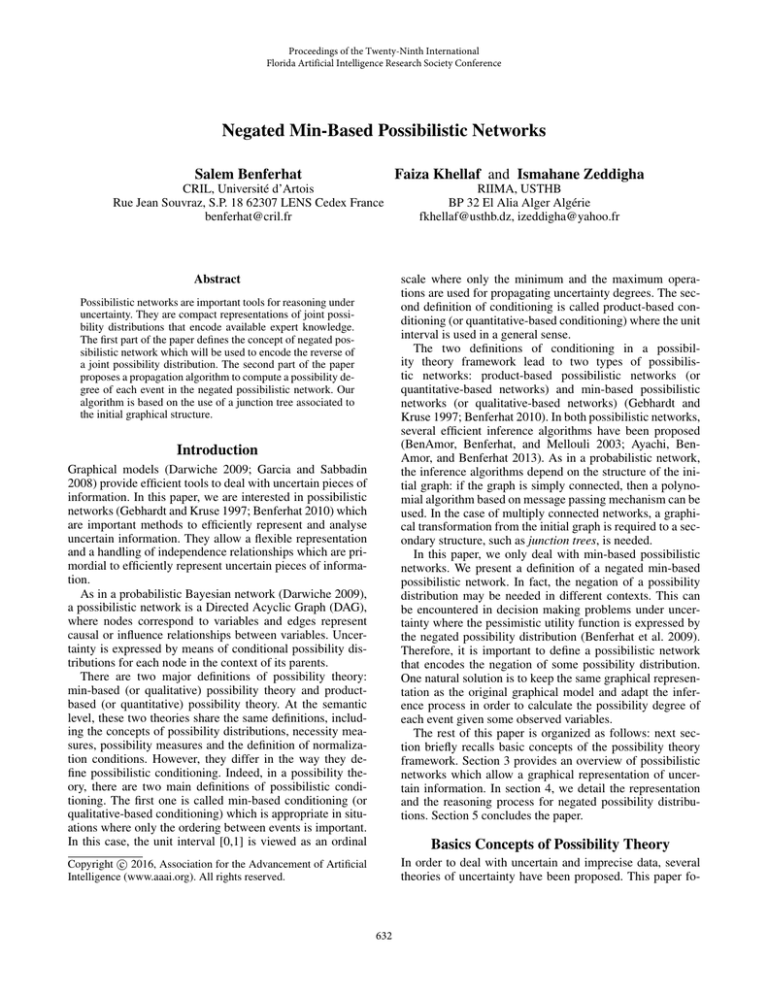
Proceedings of the Twenty-Ninth International
Florida Artificial Intelligence Research Society Conference
Negated Min-Based Possibilistic Networks
Salem Benferhat
Faiza Khellaf and Ismahane Zeddigha
CRIL, Université d’Artois
Rue Jean Souvraz, S.P. 18 62307 LENS Cedex France
benferhat@cril.fr
RIIMA, USTHB
BP 32 El Alia Alger Algérie
fkhellaf@usthb.dz, izeddigha@yahoo.fr
scale where only the minimum and the maximum operations are used for propagating uncertainty degrees. The second definition of conditioning is called product-based conditioning (or quantitative-based conditioning) where the unit
interval is used in a general sense.
The two definitions of conditioning in a possibility theory framework lead to two types of possibilistic networks: product-based possibilistic networks (or
quantitative-based networks) and min-based possibilistic
networks (or qualitative-based networks) (Gebhardt and
Kruse 1997; Benferhat 2010). In both possibilistic networks,
several efficient inference algorithms have been proposed
(BenAmor, Benferhat, and Mellouli 2003; Ayachi, BenAmor, and Benferhat 2013). As in a probabilistic network,
the inference algorithms depend on the structure of the initial graph: if the graph is simply connected, then a polynomial algorithm based on message passing mechanism can be
used. In the case of multiply connected networks, a graphical transformation from the initial graph is required to a secondary structure, such as junction trees, is needed.
In this paper, we only deal with min-based possibilistic
networks. We present a definition of a negated min-based
possibilistic network. In fact, the negation of a possibility
distribution may be needed in different contexts. This can
be encountered in decision making problems under uncertainty where the pessimistic utility function is expressed by
the negated possibility distribution (Benferhat et al. 2009).
Therefore, it is important to define a possibilistic network
that encodes the negation of some possibility distribution.
One natural solution is to keep the same graphical representation as the original graphical model and adapt the inference process in order to calculate the possibility degree of
each event given some observed variables.
The rest of this paper is organized as follows: next section briefly recalls basic concepts of the possibility theory
framework. Section 3 provides an overview of possibilistic
networks which allow a graphical representation of uncertain information. In section 4, we detail the representation
and the reasoning process for negated possibility distributions. Section 5 concludes the paper.
Abstract
Possibilistic networks are important tools for reasoning under
uncertainty. They are compact representations of joint possibility distributions that encode available expert knowledge.
The first part of the paper defines the concept of negated possibilistic network which will be used to encode the reverse of
a joint possibility distribution. The second part of the paper
proposes a propagation algorithm to compute a possibility degree of each event in the negated possibilistic network. Our
algorithm is based on the use of a junction tree associated to
the initial graphical structure.
Introduction
Graphical models (Darwiche 2009; Garcia and Sabbadin
2008) provide efficient tools to deal with uncertain pieces of
information. In this paper, we are interested in possibilistic
networks (Gebhardt and Kruse 1997; Benferhat 2010) which
are important methods to efficiently represent and analyse
uncertain information. They allow a flexible representation
and a handling of independence relationships which are primordial to efficiently represent uncertain pieces of information.
As in a probabilistic Bayesian network (Darwiche 2009),
a possibilistic network is a Directed Acyclic Graph (DAG),
where nodes correspond to variables and edges represent
causal or influence relationships between variables. Uncertainty is expressed by means of conditional possibility distributions for each node in the context of its parents.
There are two major definitions of possibility theory:
min-based (or qualitative) possibility theory and productbased (or quantitative) possibility theory. At the semantic
level, these two theories share the same definitions, including the concepts of possibility distributions, necessity measures, possibility measures and the definition of normalization conditions. However, they differ in the way they define possibilistic conditioning. Indeed, in a possibility theory, there are two main definitions of possibilistic conditioning. The first one is called min-based conditioning (or
qualitative-based conditioning) which is appropriate in situations where only the ordering between events is important.
In this case, the unit interval [0,1] is viewed as an ordinal
Basics Concepts of Possibility Theory
c 2016, Association for the Advancement of Artificial
Copyright Intelligence (www.aaai.org). All rights reserved.
In order to deal with uncertain and imprecise data, several
theories of uncertainty have been proposed. This paper fo-
632
Possibilistic Networks
cuses on possibility theory (Dubois and Prade 2012).
Let V = {A1 , ..., AN } be a set of variables. We denote by
DAi = {ai1 , ..., ain } the domain associated with the variable Ai . aij denotes any instance j of Ai . The universe of
discourse is denoted by Ω = ×Ai ∈V DAi , which is the Cartesian product of all variables’ domains in V . Each element
ω ∈ Ω is called an interpretation which represents a possible state of world (or universe of discourse). It is denoted by
ω = (a1i , ..., anm ). φ, ψ... represent subsets of Ω (events).
There are two ways to define possibilistic networks in a possibility theory framework depending on the use of possibilistic conditioning (Coletti, Petturiti, and Vantaggi 2013).
In this paper, we only focus on min-based possibilistic
networks. A min-based possibilistic network (Fonck 1992;
Benferhat 2010) over a set of variables V, denoted by
ΠGmin = (G, π), is characterized by:
1. A graphical component: which is represented by a Directed Acyclic Graph (DAG) where nodes correspond
to variables and arcs represent dependence relations between variables.
2. Numerical components: these components quantify different links in the DAG by using local possibility distributions for each node A in the context of its parents, denoted
by P ar(A). More precisely:
• For every root node A (P ar(A) = ∅), uncertainty is
represented by a priori possibility degree π(a) for each
instance a ∈ DA , such that max π(a) = 1.
Possibility Distribution
The basic element in a possibility theory is the notion of a
possibility distribution π which corresponds to a mapping
from the set of interpretations Ω to the uncertainty scale
[0, 1]. This distribution allows the encoding of our knowledge on real world. π(ω) = 1 means that ω is fully possible
and π(ω) = 0 means that it is impossible to ω to be the real
world. A possibilistic scale can be interpreted in two ways:
• in a qualitative way if the possibility degrees only reflect
an ordering between different states of the world,
• in a quantitative way if the affected values make sense in
numerical scale.
This paper focuses on ordinal interpretation of uncertainty
scales.
A possibility distribution π is said to be α−normalized, if
its normalization degree h(π) is equal to α, namely:
(1)
h(π) = max π(ω) = α.
a∈DA
• For the rest of the nodes (P ar(A) = ∅), uncertainty is
represented by the conditional possibility degree π(a |
uA ) for each instance a ∈ DA and for any instance
uA ∈ DP ar(A) (where DP ar(A) represents the Cartesian product of all variable’s domains in P ar(A)), such
that max π(a | uA ) = 1, for any uA .
a∈DA
The set of a priori and conditional possibility degrees induce
a unique joint possibility distribution πmin defined by:
πmin (A1 , ..., AN ) = min π(Ai | Ui ).
(6)
ω
If α = 1, then π is said to be normalized.
Given a possibility distribution π on the universe discourse
Ω, two dual measures are defined for each event φ ⊆ Ω:
• Possibility measure: this measure evaluates to what extent φ is consistent with our knowledge encoded by π:
(2)
Π(φ) = max{π(ω) : ω ∈ Ω and ω |= φ}.
i=1..N
One of the most common tasks performed on possibilistic networks is the possibilistic inference which consists
in determining how the realization of some specific values
of some variables, called observations or evidence, affects
the remaining variables (Huang and Darwiche 1996). The
problem of computing posteriori marginal distributions on
nodes in arbitrary possibilistic networks is known to be a
hard problem (Borgelt, Gebhardt, and Kruse 1998) except
for singly connected graphs which ensure the propagation in
polynomial time (Fonck 1992). One of well-known propagation algorithm is the so-called junction tree algorithm (Darwiche 2009). The idea is to transform the initial graph into
a tree on which the propagation algorithm can be achieved
in an efficient way. More recent works have been proposed
and based on compilation process (Darwiche 2009) (Ayachi, BenAmor, and Benferhat 2013) of parameters instead
of graphs.
ω∈Ω
• Necessity measure: it is the dual of possibility measure.
The necessity measure evaluates to which level φ is certainly implied by our knowledge, represented by π:
N (φ) = 1 − Π(¬φ).
(3)
Possibilistic conditioning (Coletti, Petturiti, and Vantaggi
2013) consists in revising the initial knowledge, encoded by
a possibility distribution π, by the arrival of a new certain information φ ⊆ Ω. The initial distribution π is then replaced
by another one, denoted π = π(. | φ). The two interpretations of the possibilistic scale (qualitative and quantitative)
induce two definitions of possibilistic conditioning: productbased conditioning and min-based conditioning. In this paper, we only focus on min-based conditioning defined by:
1
If π(ω) = Π(φ) and ω ∈ φ
π(ω) If π(ω) < Π(φ) and ω ∈ φ
π(ω | φ) =
(4)
0
otherwise.
We also use a so-called min-based independence relation,
also known as a non-interactivity relation. This relation is
obtained by using the min-based conditioning (Equation 4)
and it is defined by:
∀x, y, z Π(x ∧ y | z) = min(Π(x | z), Π(y | z)).
(5)
Negated Possibilistic Network
This section contains the main contributions of this paper which consists in defining the syntactic counterpart of
negated possibility distributions. In many situations, one
may need to compute negated possibility distributions. For
instance, in decision making under uncertainty, computing
pessimistic decision comes down to choosing a decision
d ∈ D which maximises the qualitative utility given by:
u∗ (d) = minω∈Ω max(1 − π(ω), μ(ω))
633
where D is a set of decisions, π and μ are two possibility
distributions representing agent’s beliefs and preferences respectively. The natural question in this case is: if π and μ are
compactly represented by two min-based possibilistic networks, how to represent (1 − μ) by a min-based possibilistic
networks? Our aim consists then in defining a new possibilistic network ΠGneg = (G , πN ) encoding the joint possibility distribution πneg = 1 − πmin which corresponds to
the negation of the first network ΠGmin . Once the negated
possibilistic network is defined, we show how to perform
queries over ΠGneg .
Proof. The proof is immediate. By definition, we have :
πneg (A1 , ..., AN )
i=1..N
= 1 − min π(Ai | Ui )
i=1..N
= 1 − πmin (A1 , ..., AN ).
Example 1. Let us consider the min-based network
ΠGmin = (G, π), composed of the DAG of Figure 1 and
the initial possibility distributions associated with variables
X, Y, Z and V are given in tables 2 and 1. We assume that
the variables are binary variables.
Recall that a min-based possibilistic network ΠGmin =
(G, π) is defined by its graphical component G and a set of
conditional possibility distributions π(Ai | UAi ), ∀Ai ∈ V .
It encodes a unique joint possibility distribution πmin described by equation 6.
The negated min-based possibilistic network ΠGneg =
(G , πN ) is defined as follows:
X
Z
Y
Definition 1. Let ΠGmin = (G, π) be a min-based possibilistic network.
V
• It has the same graphical component as ΠGmin namely:
G = G,
• The negated possibility distributions relative to each variable A ∈ v is given by:
– For each root node, ∀a ∈ DA πN (a) = 1 − π(a),
– For the rest of the node, ∀a ∈ DA and ∀uA ∈ DP ar(A)
πN (a | uA ) = 1 − π(a | uA ).
Figure 1: Example of DAG
Table 1: Initial possibility distributions and their negation.
X π(X) πN (X)
x
.1
.9
¬x
1
0
The set of a priori and conditional possibility degrees induces a unique joint possibility distribution defined by the
following max-based chain rule:
Table 2: Initial possibility distributions and their negation on
Y given X.
Y
X π(Y | X) πN (Y | X)
y
x
.9
.1
y
¬x
1
0
¬y
x
1
0
¬y ¬x
.6
.4
Definition 2. Given a negated min-based possibilistic network ΠGneg = (G, πN ), we define its associated joint possibility distribution, denoted by πneg , using the following
max-based chain rule:
i=1..N
(7)
Table 3: Initial possibility distributions and their negation on
Z given X.
Z
X π(Z | X) πN (Z | X)
z
x
.2
.8
z
¬x
1
0
¬z
x
1
0
¬z ¬x
1
0
The following proposition guarantees that the negated
possibilistic network encodes the joint possibility πneg =
1 − πmin . Note that in the Definition 2, the joint distribution
is defined using the maximum operation instead of minimum
operation. This leads to a definition similar to the notion of
guaranteed possibility distributions defined in (Dubois, Hajek, and Prade 2000). Hence, to some extent, a negated minbased network can be viewed as a guaranteed-based network
(Ajroud et al. 2009) and guaranteed-based possibilistic logic
can be used to represent preferences (Benferhat et al. 2002).
Table 4: Initial possibility distributions and their negation on
V given Y and Z.
Proposition 1. Let ΠGmin = (G, π) be a min-based possibilistic network encoding the possibility distribution πmin .
Let ΠGneg be the negated min-based possibilistic network
associated with ΠGmin using the above definitions (Definition 1 and Definition 2). Then, we have:
πneg (A1 , ..., AN ) = 1 − πmin (A1 , ..., AN )
i=1..N
= max [1 − π(Ai | Ui )]
Construction of Negated Possibilistic Network
πneg (A1 , ..., AN ) = max πN (Ai | Ui )
= max πN (Ai | Ui )
V
v
v
v
v
(8)
634
Y
Z π(V |Y,Z) πN (V |Y,Z) V
y z
y ¬z
¬y z
¬y ¬z
.8
1
.2
.3
.2
0
.8
.7
Y
Z π(V |Y,Z) πN (V |Y,Z)
¬v y z
¬v y ¬z
¬v ¬y z
¬v ¬y ¬z
1
.7
1
1
0
.3
0
0
The negated possibilistic network ΠGneg = (G, πN ) is
such that its graphical component is the same as the one
given by the DAG of Figure 1. Its numerical component is
the negation of possibility distributions given in Tables 1, 2,
3 and 4.
Using the min-based chain rule (Equation 6) we obtain
the joint possibility distribution given in table 5. The joint
A) Building junction tree:
The construction of the junction tree J T from the initial
DAG G needs three steps (Darwiche 2009):
1. Moralization of the initial graph G⊕ : It consists in
creating an undirected graph from the initial one by
adding links between the parents of each variable, and
replacing directed arcs by undirected ones.
2. Triangulation of the moral graph: It allows to identify sets of variables that can be gathered as clusters
or cliques denoted by Ci . Several heuristics have been
proposed in order to find the best triangular graph
which minimizes the size of clusters.
3. Construction of the optimal junction tree J T : A
junction tree is built, as in the case of Bayesian networks, by connecting the clusters, representing cliques
of the triangulated graph, identified in the previous
step. Once adjacent clusters have been identified,
between each pair of clusters Ci and Cj , a separator
Sij containing their common variables, is inserted.
Table 5: Joint possibility distribution πmin and its negation
πneg .
X
x
x
x
x
x
x
x
x
Y
y
y
y
y
¬y
¬y
¬y
¬y
Z
z
z
¬z
¬z
z
z
¬z
¬z
V πmin πneg
v
.1
.9
¬v .1
.9
v
.1
.9
¬v .1
.9
v
.1
.9
¬v .1
.9
v
.1
.9
¬v .1
.9
X
¬x
¬x
¬x
¬x
¬x
¬x
¬x
¬x
Y
y
y
y
y
¬y
¬y
¬y
¬y
Z
z
z
¬z
¬z
z
z
¬z
¬z
V πmin πneg
v
.8
.2
¬v
1
0
v
1
0
¬v .7
.3
v
.2
.8
¬v .6
.4
v
.3
.7
¬v .6
.4
possibility distribution associated with ΠGneg obtained using the max-based chain rule (Equation 7) is given by the
same table (in bold). We can for instance check that:
πneg (¬x, y, z, v) = 1 − πmin (¬x, y, z, v)
Indeed,
πneg (¬x, y, z, v) =
max(πN (¬x), πN (y | ¬x), πN (z | ¬x), πN (v | y, z)).
Then,
πneg (¬x, y, z, v) = max(0, 0, 0, .2) = .2
1 − πmin (¬x, y, z, v) = 1 − .8 = .2
B) Propagation process:
The propagation process involves two steps:
1. Initialization: Once the junction tree is achieved, we
proceed to quantify this new structure by transforming initial conditional possibility distributions into local
joint distributions attached to each cluster and separator.
For each cluster Ci (respectively separator Sij ), we assign a potential πCi (respectively πSij ).
Definition 3. Let J T be a junction tree associated
with the initial graph G. The unique joint distribution,
noted πJ T associated to the junction tree J T is
defined by:
Next section shows how to propagate uncertainty in
negated possibilistic networks.
Uncertainty Propagation in Negated Possibilistic
Network
πJ T (A1 , ..., AN ) = max πCi ,
i=1..m
The negated min-based possibilistic network defined just
above will be used for computing a marginal distribution for
each variable. More precisely, we propose a propagation algorithm in the spirit of the one based on junction tree structure. The principle of our algorithm is to transform the initial graph into a secondary structure known as a junction tree
noted J T (Darwiche 2009). The procedure of building the
junction tree is the same as the one used in a probabilistic
Bayesian network and in a min-based possibilistic network.
However, the propagation step in negated networks is different from the one used in probabilistic Bayesian networks and
the one used in min-based possibilistic networks. Indeed, the
propagation process in negated possibilistic networks is reduced in two steps, instead of the three stages identified in
the propagation process in possibilistic networks (BenAmor,
Benferhat, and Mellouli 2003). The first step consists in initialization of the junction tree allowing its quantification using the initial distributions. The second one, associated with
handling queries, allows to provide the marginal distribution
for each variable.
More precisely, the different steps can be depicted as follows:
(9)
where m is the number of clusters in J T .
The quantification of the junction tree J T is done using the initial possibility distributions as follows:
• For each cluster Ci , πCi ← 0,
• For each separator Sij , πSij ← 0,
• For each variable Ai , choose a cluster Ci containing
{Ai } ∪ {P ar(Ai )}: πCi = max(πCi , πN (Ai | Ui )).
The following proposition shows that the initialized
junction tree encodes the same possibility distribution
as the one of initial negated possibilistic network.
Proposition 2. Let ΠGneg = (G, πN ) be the
negated min-based possibilistic network associated
with ΠGmin . Let J T be the junction tree corresponding to ΠGneg generated using the above initialization
procedure. Let πneg be the joint distribution encoded
by ΠGneg using Equation 7 and πJ T be the joint possibility distribution encoded by J T using Equation 9.
Then, ∀i, i = 1, ..., n
πneg (A1 , ..., AN ) = πJ T (A1 , ..., AN ).
635
(10)
2. Handling queries:
The computation of the marginal possibility distributions relative to each variable Ai ∈ V can be accomplished by marginalizing the potential of each cluster
and choosing the maximum one as follows:
Proposition 3. Let ΠGneg = (G, πN ) be the negated
min-based possibilistic network associated to ΠGmin .
Let J T be the junction tree corresponding to ΠGneg
generated using the above initialization procedure.
The possibility distribution πN (Ai ) relative to each
variable Ai ∈ V is done by:
∀Ai ∈ V, πN (Ai = ai ) = max max πCi
i=1..m Ai =ai
X
x
x
x
x
¬x
¬x
¬x
¬x
(11)
Table 6: Potentials affected to clusters.
Y
Z πC 1
Y
Z
V
πC 2
y
z
.9
y
z
v
.2
y
¬z
.9
y
z
¬v
0
¬y
z
.9
y
¬z
v
0
¬y ¬z
.9
y
¬z ¬v
.3
y
z
0
¬y
z
v
.8
y
¬z
0
¬y
z
¬v
0
¬y
z
.4
¬y ¬z
v
.7
¬y ¬z
.4
¬y ¬z ¬v
0
Proof. The proof is immediate. Indeed,
πN (Ai = ai )
Table 7: Joint possibility distribution associated to J T .
= πJ T (Ai = ai )
= max πJ T (A1 , .., ai , .., AN )
X
x
x
x
x
x
x
x
x
V \Ai
= max [ max πCi ]
V \Ai i=1..m
by using Equation 9
= max [max πCi ]
i=1..m V \Ai
= max [ max πCi ].
i=1..m Ai =ai
Example 2 (Example continued).
• Applying the procedure described above, the junction tree
associated with the DAG of Figure 1, is given by Figure 2.
it contains two clusters
C1 = {X, Y, Z} and
C2 = {Y, Z, V } and their separator
S12 = {Y, Z}.
XY Z
YZ
Y
y
y
y
y
¬y
¬y
¬y
¬y
Z
z
z
¬z
¬z
z
z
¬z
¬z
V
v
¬v
v
¬v
v
¬v
v
¬v
πJ T (X,Y,Z,V )
.9
.9
.9
.9
.9
.9
.9
.9
X
¬x
¬x
¬x
¬x
¬x
¬x
¬x
¬x
Y
y
y
y
y
¬y
¬y
¬y
¬y
Z
z
z
¬z
¬z
z
z
¬z
¬z
V
v
¬v
v
¬v
v
¬v
v
¬v
πJ T (X,Y,Z,V )
.2
0
0
.3
.8
.4
.7
.4
lows:
πC2 (yzv)
= max(0, πN (v | yz))
= max(0, .2)
= .2.
The joint possibility distribution induces by junction tree
is computed using Equation 9. The corresponding results
are reported in Table 7.
• For the propagation, we need to compute the marginal
possibility distribution πN (¬x).
Using Equation 11, we get:
Y ZV
Figure 2: Junction tree
πN (¬x)
= max(max πC1 , max πC2 )
YZ
= max(.4, .8)
= .8.
• For the quantification step of the obtained junction tree,
the potential assigned to each cluster is given in Table 6.
As the variable x has no parent, the variable Y is with
its parent in C1 and similarly for the variable Z. The initialization procedure affects the potential πC1 for the first
cluster as follows:
Y ZV
We get the same result using the negated min-based possibilistic network. Indeed,
πN (¬x) = max πneg = .8.
Y ZV
πC1 = max(0, πN (X), πN (Y | X), πN (Z | X)).
However, the variable V is with their parents (Y and Z)
in the second cluster C2 . From the initialization procedure, the potential πC2 is given by:
Conclusion
This paper proposed a compact representation of the negation of a possibility distribution. The obtained negated minbased possibilistic network preserves the same graphical
component as the initial min-based possibilistic network. It
also induces a unique joint possibility distribution obtained
πC2 = max(0, πN (V | Y, Z)).
For example, the potential πC2 (yzv) is computed as fol-
636
by a max-based chain rule. The propagation process allows
the computation of marginal distributions using junction
tree. This result is important since it shows that the computational complexity of querying a negated possibilistic network is the same as the one of querying a standard minbased possibilistic network. As future works, we plan to apply the results of this paper for computing pessimistic optimal decisions (BenAmor, Fargier, and Guezguez 2014) (BenAmor, Essghaier, and Fargier 2014). Indeed, pessimistic
utility is expressed by the negation of possibility distribution representing agent’s knowledge. Thus, by analogy to the
work developed in (Benferhat, Khellaf, and Zeddigha 2015)
for optimistic criteria, the proposed framework will leads to
offer a new graphical model for computing optimal decision
using pessimistic criteria.
sibility theory framework. , 2014. Computing and Informatics 5.
Benferhat, S. 2010. Graphical and logical-based representations of uncertain information in a possibility theory framework. In Scalable Uncertainty Management 4th International Conference (SUM), 3–6.
Borgelt, C.; Gebhardt, J.; and Kruse, R. 1998. Inference methods. In Handbook of Fuzzy Computation. Bristol,
United Kingdom: Institute of Physics Publishing. chapter
F1.2.
Coletti, G.; Petturiti, D.; and Vantaggi, B. 2013. Independence in possibility theory under different triangular
norms. In Symbolic and Quantitative Approaches to Reasoning with Uncertainty - 12th European Conference, ECSQARU, Utrecht, The Netherlands., 133–144.
Darwiche, A. 2009. Modeling and Reasoning with Bayesian
Networks. New York, NY, USA: Cambridge University
Press, 1st edition.
Dubois, D., and Prade, H. 2012. Possibility theory and
formal concept analysis: Characterizing independent subcontexts. Fuzzy Sets and Systems 196:4–16.
Dubois, D.; Hajek, P.; and Prade, H. 2000. Knowledgedriven versus data-driven logics. Journal of Logic, Language, and Information 9:65–89.
Fonck, P. 1992. Propagating uncertainty in directed acyclic
graphs. In Proceedings of the fourth IPMU Conference,
1720.
Garcia, L., and Sabbadin, R. 2008. Complexity results and
algorithms for possibilistic influence diagrams. Artif. Intell.
172(8-9):1018–1044.
Gebhardt, J., and Kruse, R. 1997. Background and perspectives of possibilistic graphical models. In 4th European Conference on Symbolic and Quantitative Approaches
to Reasoning and Uncertainty (ECSQARU’97), LNAI 2143,
108–121.
Huang, C., and Darwiche, A. 1996. Inference in belief
networks: A procedural guide. Int. J. Approx. Reasoning
15(3):225–263.
Acknowledgements
This work has received supports from the french Agence Nationale de la Recherche, ASPIQ project reference ANR-12BS02-0003. This work has also received support from the
european project H2020 Marie Sklodowska-Curie Actions
(MSCA) research and Innovation Staff Exchange (RISE):
AniAge (High Dimensional Heterogeneous Data based Animation Techniques for Southeast Asian Intangible Cultural
Heritage.
References
Ajroud, A.; Benferhat, S.; Omri, M.; and Youssef, H.
2009. On the guaranteed possibility measures in possibilistic networks. In Proceedings of the Twenty Second International Florida Artificial Intelligence Research Society
(FLAIRS’09), 517–522.
Ayachi, R.; BenAmor, N.; and Benferhat, S. 2013. A comparative study of compilation-based inference methods for
min-based possibilistic networks. In ECSQARU, 25–36.
BenAmor, N.; Benferhat, S.; and Mellouli, K. 2003.
Anytime propagation algorithm for min-based possibilistic
graphs. Soft Comput. 8(2):150–161.
BenAmor, N.; Essghaier, F.; and Fargier, H. 2014. Solving multi-criteria decision problems under possibilistic uncertainty using optimistic and pessimistic utilities. In Information Processing and Management of Uncertainty in
Knowledge-Based Systems - 15th International Conference
(IPMU). Proceedings, Part III, 269–279.
BenAmor, N.; Fargier, H.; and Guezguez, W. 2014. Possibilistic sequential decision making. Int. J. Approx. Reasoning 55(5):1269–1300.
Benferhat, S.; Dubois, D.; Kaci, S.; and Prade, H. 2002.
Bipolar possibilistic representations. In 18th Conference in
Uncertainty in Artificial Intelligence (UAI’02), 45–52.
Benferhat, S.; Haned-Khellaf, F.; Mokhtari, A.; and Zeddigha, I. 2009. Using syntactic possibilistic fusion
for modeling optimal optimistic qualitative decision. In
IFSA/EUSFLAT Conf., 1712–1716.
Benferhat, S.; Khellaf, F.; and Zeddigha, I. 2015. A new
graphical model for computing optimistic decisions in a pos-
637

